| Weight | 1 lbs |
|---|---|
| Dimensions | 9 × 5 × 2 in |
| host | mouse |
| isotype | IgG2b |
| clonality | monoclonal |
| concentration | concentrate, predilute |
| applications | IHC |
| reactivity | human |
| available size | 0.1 mL, 0.5 mL, 1 mL concentrated, 7 mL prediluted |
mouse anti-CD163 monoclonal antibody (ZM29) 6066
Price range: $160.00 through $528.00
Antibody summary
- Mouse monoclonal to CD163
- Suitable for: Immunohistochemistry (formalin-fixed, paraffin-embedded tissues)
- Reacts with: Human
- Isotype:IgG2b
- Control: Liver
- Visualization: Cytoplasmic and membranous
- 0.1, 0.5, 1.0 mL concentrated, 7 mL prediluted
mouse anti-CD163 monoclonal antibody ZM29 6066
| target relevance |
|---|
| Protein names Scavenger receptor cysteine-rich type 1 protein M130 (Hemoglobin scavenger receptor) (CD antigen CD163) [Cleaved into: Soluble CD163 (sCD163)] |
| Gene names CD163,CD163 M130 |
| Mass 125451Da |
| Function FUNCTION: Acute phase-regulated receptor involved in clearance and endocytosis of hemoglobin/haptoglobin complexes by macrophages and may thereby protect tissues from free hemoglobin-mediated oxidative damage. May play a role in the uptake and recycling of iron, via endocytosis of hemoglobin/haptoglobin and subsequent breakdown of heme. Binds hemoglobin/haptoglobin complexes in a calcium-dependent and pH-dependent manner. Exhibits a higher affinity for complexes of hemoglobin and multimeric haptoglobin of HP*1F phenotype than for complexes of hemoglobin and dimeric haptoglobin of HP*1S phenotype. Induces a cascade of intracellular signals that involves tyrosine kinase-dependent calcium mobilization, inositol triphosphate production and secretion of IL6 and CSF1. Isoform 3 exhibits the higher capacity for ligand endocytosis and the more pronounced surface expression when expressed in cells.; FUNCTION: After shedding, the soluble form (sCD163) may play an anti-inflammatory role, and may be a valuable diagnostic parameter for monitoring macrophage activation in inflammatory conditions. |
| Subellular location SUBCELLULAR LOCATION: [Soluble CD163]: Secreted {ECO:0000269|PubMed:12296867}.; SUBCELLULAR LOCATION: Cell membrane {ECO:0000269|PubMed:10577520, ECO:0000269|PubMed:10648003}; Single-pass type I membrane protein {ECO:0000269|PubMed:10577520, ECO:0000269|PubMed:10648003}. Note=Isoform 1 and isoform 2 show a lower surface expression when expressed in cells. |
| Tissues TISSUE SPECIFICITY: Expressed in monocytes and mature macrophages such as Kupffer cells in the liver, red pulp macrophages in the spleen, cortical macrophages in the thymus, resident bone marrow macrophages and meningeal macrophages of the central nervous system. Expressed also in blood. Isoform 1 is the lowest abundant in the blood. Isoform 2 is the lowest abundant in the liver and the spleen. Isoform 3 is the predominant isoform detected in the blood. {ECO:0000269|PubMed:10577520, ECO:0000269|PubMed:11196644, ECO:0000269|PubMed:16434690}. |
| Structure SUBUNIT: Interacts with CSNK2B. {ECO:0000269|PubMed:11298324}. |
| Post-translational modification PTM: A soluble form (sCD163) is produced by proteolytic shedding which can be induced by lipopolysaccharide, phorbol ester and Fc region of immunoglobulin gamma. This cleavage is dependent on protein kinase C and tyrosine kinases and can be blocked by protease inhibitors. The shedding is inhibited by the tissue inhibitor of metalloproteinase TIMP3, and thus probably induced by membrane-bound metalloproteinases ADAMs. {ECO:0000269|PubMed:10066432, ECO:0000269|PubMed:12296867, ECO:0000269|PubMed:15075364, ECO:0000269|PubMed:15448162}.; PTM: Phosphorylated. {ECO:0000305|PubMed:11298324}. |
| Domain DOMAIN: The SRCR domain 3 mediates calcium-sensitive interaction with hemoglobin/haptoglobin complexes. {ECO:0000269|PubMed:15448162}. |
| Target Relevance information above includes information from UniProt accession: Q86VB7 |
| The UniProt Consortium |
Data
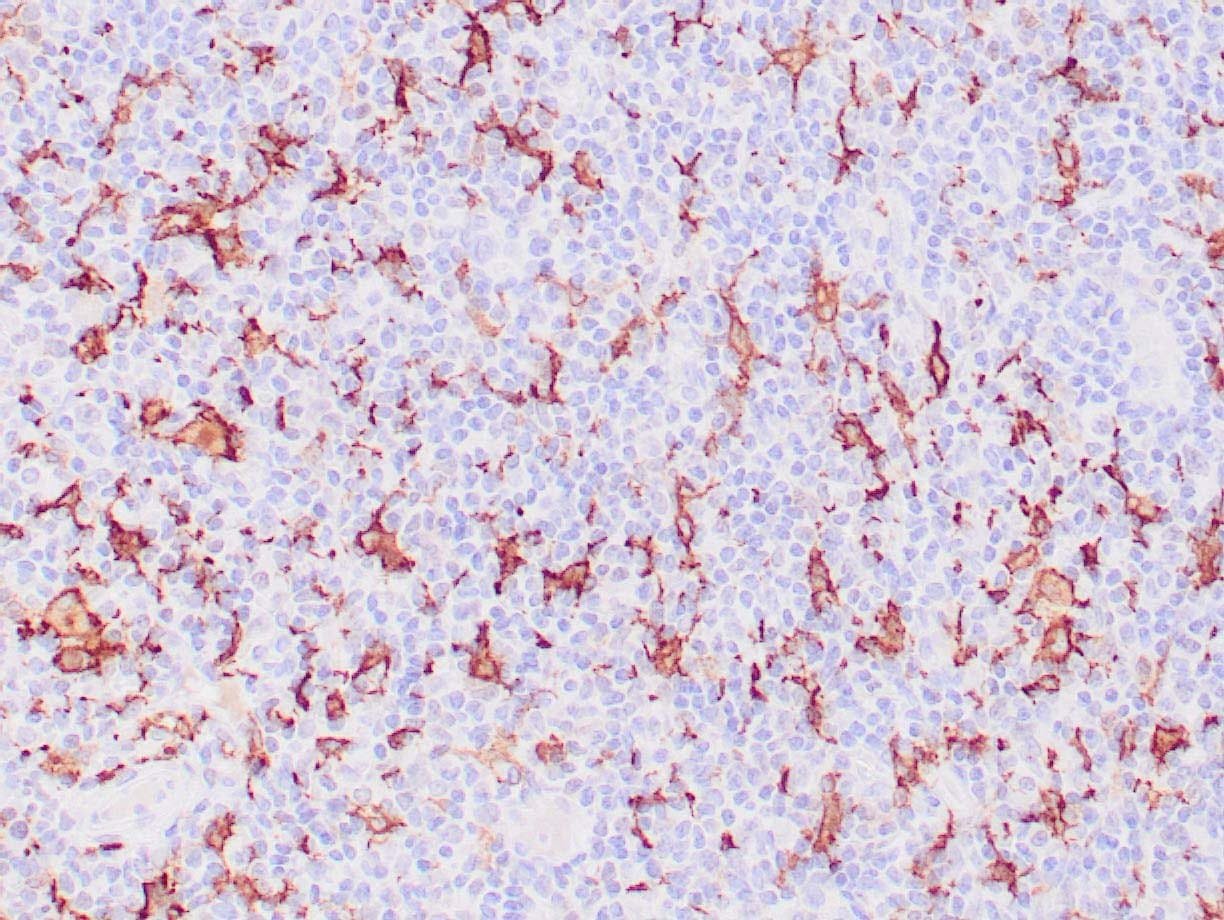 |
| Human lymph node stained with anti-CD163 antibody using peroxidase-conjugate and DAB chromogen. Note membrane staining of histiocytes. |
Publications
| pmid | title | authors | citation |
|---|---|---|---|
| We haven't added any publications to our database yet. | |||
Protocols
| relevant to this product |
|---|
| IHC |
Documents
| # | SDS | Certificate | |
|---|---|---|---|
| Please enter your product and batch number here to retrieve product datasheet, SDS, and QC information. | |||
Only logged in customers who have purchased this product may leave a review.

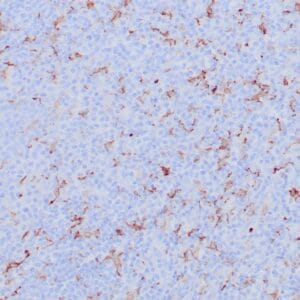

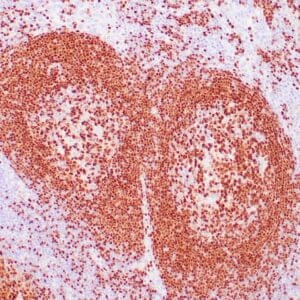
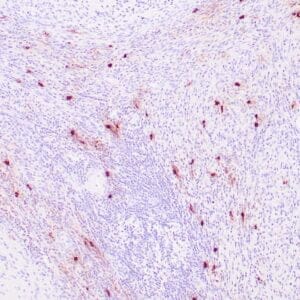
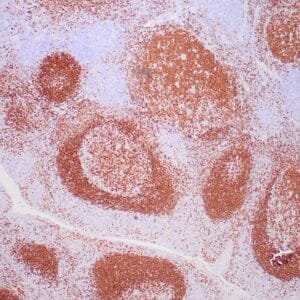


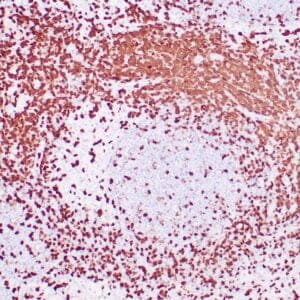

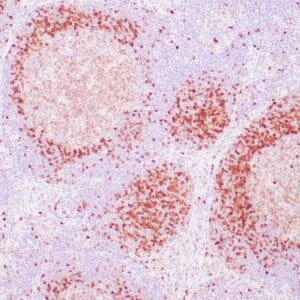

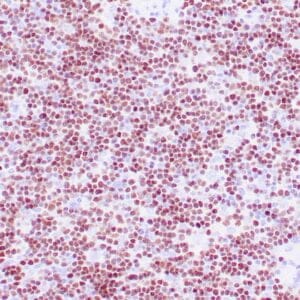
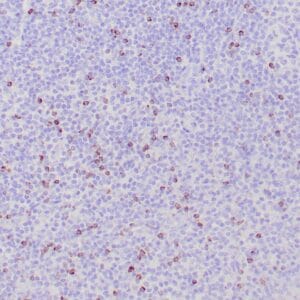
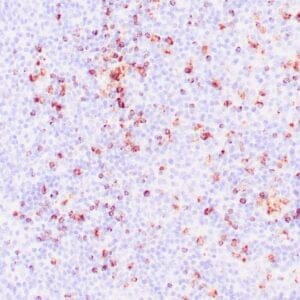
Reviews
There are no reviews yet.